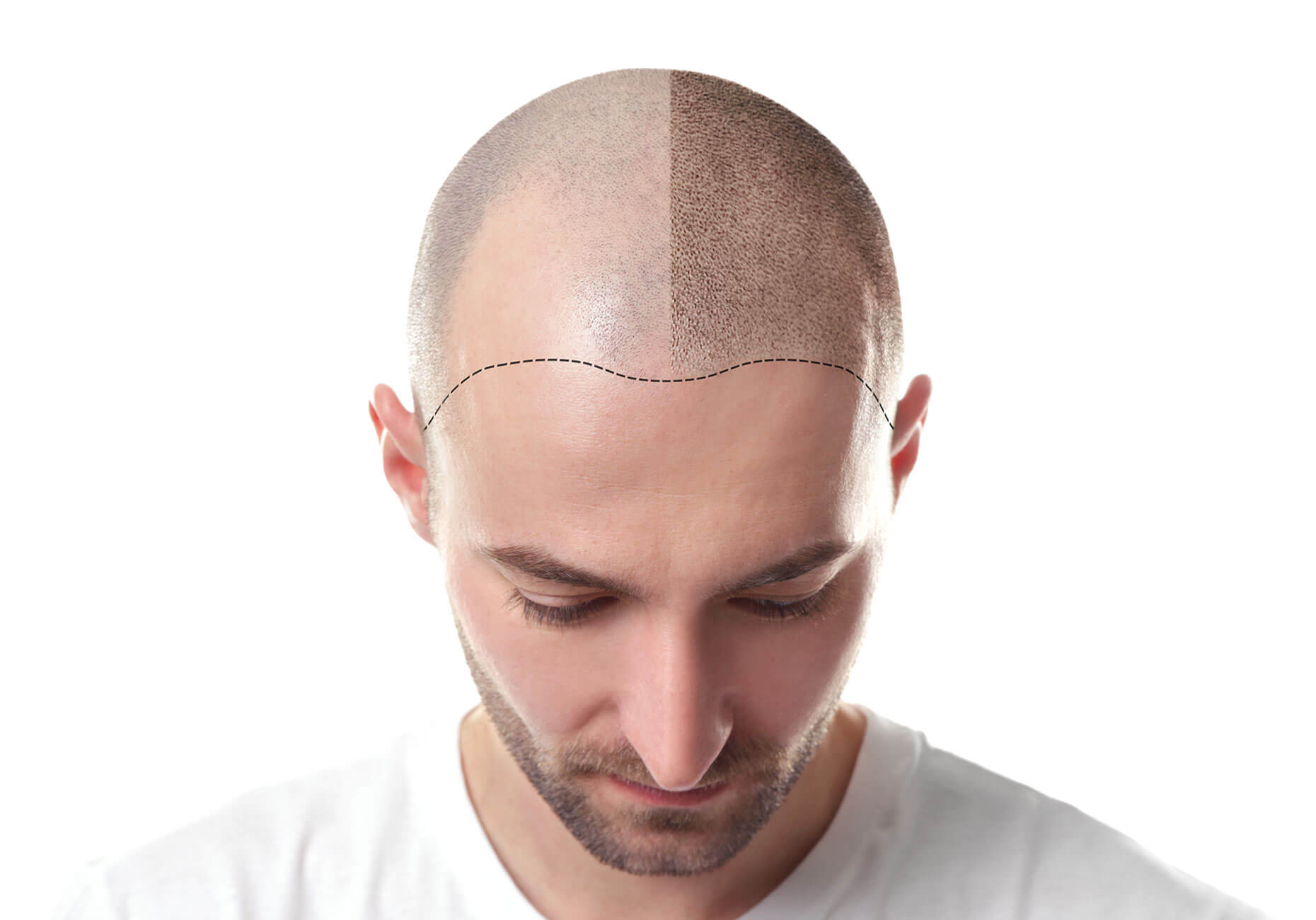Do you feel like you have thinning hair at the front of your head? How about an eroding or uneven hairline? Maybe you’re seeing these issues and thinking of family members who have gone bald. If so, it’s no surprise that changes to your hairline make you want to panic.
As we age, we’re likely to see changes to our hair – and some amount of change to your hairline is just a normal part of getting older. But for some people, a bad hairline is also one of the first signs of hair loss.
Normal vs. abnormal hairline changes
Do you remember what your hairline looked like when you were a teenager? Your hair was probably full and thick. You probably felt like you could have just about any hairstyle and look good no matter what.
Unfortunately, this isn’t all in your head. According to a study in the Facial Plastic Surgery Clinics Of North America Journal, kids all start out with the same concave hairline. By kindergarten, you start to see minimal changes – like the development of widow’s peaks. Other changes to your hairline, like temporal peaks, may start once you hit your mid-to-late teens.
By the time you reach adulthood, your hairline has gradually receded. However, this type of receding hairline is perfectly normal. It’s simply referred to as a mature hairline.
The main change you’ll see as you age is that hairline growth moves from the concave shape you had during your youth to a convex shape, where the middle of your hairline is thicker than the edges. Some of your hair will also start to grow in different directions, which can affect the way your hairline looks.
Changes to your hairline can be dramatic. But for most people, age-related hairline changes are minimal and gradual. In fact, you’ve probably hardly noticed them happening, and only notice when you see much younger photos of yourself.
Hairline recession can also be abnormal, though. Instead of the typical changes that occur, some men and women start experiencing hair loss while very young. In fact, hair loss can even occur to teens.

An uneven, receding hairline can eventually turn into much more extreme temple hair loss
Reasons people have bad hairlines
Hairline changes can be a normal part of aging. However, hormones, genetics, and the way you treat your hair can also affect your hairline. If you feel that you have a bad hairline or are experiencing changes to your hairline growth, it’s likely that one or several of these factors has been the culprit.
For example, women and men with long hair often tie their hair back into tight ponytails or buns or braid their hair. The Facial Plastic Surgery Clinics Of North America Journal study says that tight hairstyles like these can lead to a type of hair loss known as traction alopecia. When this happens, your hairline is essentially being influenced by repeatedly pulling your hair back.
Hormones and genetics also play a role in your hairline. In fact, genetics is thought to affect the hair of up to 50 percent of people and cause hair loss problems at some point in their lives.
According to a study in the Journal of Cutaneous and Aesthetic Surgery, a receding hairline is actually one of the first signs of male pattern hair loss (androgenic alopecia). When people with this type of hair loss – which is actually the most common cause of balding – first start to notice symptoms, they usually see issues like weak, thin hair or an irregular hairline.
If left untreated, these androgenic alopecia symptoms will gradually get worse. Hair loss will progress to the areas around the temples and very top of the head, eventually causing baldness.
How to tell if your hairline is receding
The signs of a receding hairline are pretty easy to spot. You’ll see issues like:
- A patchy or uneven hairline framing your face
- A large amount of baby hairs or tiny, broken hairs surrounding your hairline
- Thin, weak hair at your hairline and temples
- An increase in the size of your forehead
But how do you really know if your forehead is larger? After all, it could just be you feeling self conscious on a particular day, right? Or maybe you woke up one day and suddenly noticed a change that had been there for a long time.
Most people’s hairlines change naturally between their late teens and late 20s. The study published in the Facial Plastic Surgery Clinics Of North America Journal reported that men are likely to see the development of a mature hairline when they’re between 18 and 29 years of age.
If you start seeing sudden or major changes to the size of your forehead, particularly if you’re past that age range, there’s a good chance that you’re seeing a receding hairline. But the easiest way to be certain of this is by simply measuring any changes to your hairline.
Measuring hairline changes
The average man’s hairline recedes between 1.5 to 2 centimeters as their hairline matures. Hairlines pushed back further than this amount are usually the ones affected by androgenic alopecia. To determine if your hairline has receded more than this, you just need to find the highest wrinkle on your forehead by raising your eyebrows. This is where your hairline used to be when you were a child.
Measure the distance between this wrinkle and your hairline with a measuring tape. If you don’t have a measuring tape, you can also just use your index finger. Why? A study in the Journal of Biomechanical Engineering says that the average person has an index finger with a width between 1.6 and 2 centimeters — coincidentally the exact amount you’re trying to measure.
How to stop a receding hairline from getting worse
If you’ve noticed that you have a receding hairline, you’re actually lucky. The faster you can address your hair loss, the easier it is to tackle the problem.
Make positive haircare changes
If your hairline issues are caused by traction alopecia, there are some pretty simple lifestyle changes you can make to prevent further hair loss. Simply avoiding tight hairstyles and tying your hair back loosely can help a ton.
You might also want to consider the way you treat your hair. Improving your scalp microbiome and nourishing your hair with nutrients can always help, regardless of the type of hair loss you’re experiencing.
Start a hair loss treatment
If you think you’re suffering from male pattern hair loss, you should definitely take action before your receding hairline progresses. This is the optimal time to look at treatments as you can take them preventatively, instead of trying to grow back hair once it’s lost.
The most common recommended treatments include minoxidil, finasteride, and low-level laser therapy, which have all been approved by the Food and Drug Administration. They might also talk to you about your diet or hair care routine and suggest other positive lifestyle changes that can help counteract your hair loss.
Just keep in mind that it usually takes a little while for hair loss treatments to have any effect. Most people only start to see results after about 3 months of using their treatment. This delay is mainly because of the hair growth cycle — it takes time for your hair follicles to produce new, healthy hair.
Consider a cosmetic alternative like scalp micropigmentation
Waiting for a hair loss treatment to start working can be frustrating. If you’re looking for a solution in the meantime, it may be beneficial for you to explore cosmetic options.
If you have a patchy hairline that just needs to be filled in a bit, aesthetic treatments like micropigmentation can help. However, this scalp tattoo is not an option for everyone. Whether or not it will work well for you will largely depend on your hair type, hair cut, and hairstyle, as well as your hair color and how often you dye your hair.
If you choose to get scalp micropigmentation, keep in mind that it’s a semi-permanent solution. According to the book Hair and Scalp Treatments: A Practical Guide, these temporary scalp tattoos can last between 5 to 10 years.
Change your look
If you have very short hair and don’t want scalp micropigmentation, a receding hairline can be particularly problematic. While it may seem counterintuitive, it may actually be sensible to try growing out your hair. This isn’t a long term solution, especially for people with pattern hair loss, but it can be a good strategy for people who are waiting for a hair loss treatment to start working.
The best haircut for a receding hairline will mask any thinning or uneven growth. Even just sweeping your hair to the front so that the thicker hair in the back of your head is pushed forward can help hide a bad hairline.
Consider a hair loss surgery
If your receding hairline is quite severe, you may need to look into different hair loss treatment options. Some people with non-progressive types of hair loss choose to have hairline correction, which requires a hair transplantation procedure to be performed.
If you have pattern hair loss, though, you’ll likely be offered one of two types of hair loss transplants: FUE (follicular unit extraction) and FUT (follicular unit transplantation). In both cases, hair follicles are taken from the back of the head and transplanted into balding areas. However, FUE extracts individual hair follicles and FUT extracts a strip of skin, from which follicles are then harvested.
People with extensive symptoms of androgenic alopecia often have FUT, but may also end up getting both procedures. If your hair loss is minimal and your hairline is the main thing bothering you, your surgeon will likely recommend FUE.
A report in the journal Hair Transplant Forum International also mentioned combining scalp micropigmentation with a transplant to augment the appearance of the final result. Combining these strategies can also help hide any post-surgical scarring.
Does a receding hairline mean baldness is imminent?
Changes to your hairline are to be expected as you age – and some people are more likely to experience dramatic hairline changes than others. However, if you notice thinning hair, an uneven hairline, or hairline changes affecting your temples, your bad hairline will likely be related to a type of hair loss called androgenic alopecia.
Catching hairline changes early is the best way to prevent the progression of pattern hair loss. The FDA recommends using minoxidil, finasteride, or low level laser therapy treatments to counteract hair loss and stop any more hair from falling out.
If these FDA-approved treatments don’t work well for you, you may want to talk to your doctor about an alternative treatment strategy, like a hair loss transplant. Follicular unit excision (FUE) is a straightforward but expensive way to fix a bad hairline. But if you’ve caught your symptoms early, this procedure will require a minimal amount of hair grafts and can be reasonably affordable.
If surgery isn’t for you, or your FUE transplant didn’t work, you can also try scalp micropigmentation. This cosmetic procedure is a temporary scalp tattoo that will likely last between 5 and 10 years. It can help fill in patchy spots and fix the appearance of hairline irregularities.
Regardless of what you choose, be aware that androgenic alopecia is progressive. This means that FUE and scalp micropigmentation are both temporary solutions. You’ll still require a hair loss treatment (or repeated transplantation procedures) to counteract this common cause of balding.





